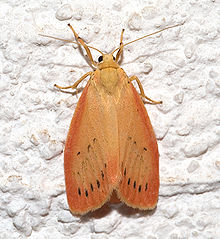Miltochrista miniata
| Rosy footman | |
|---|---|

| |
| Scientific classification | |
| Domain: | Eukaryota |
| Kingdom: | Animalia |
| Phylum: | Arthropoda |
| Class: | Insecta |
| Order: | Lepidoptera |
| Superfamily: | Noctuoidea |
| Family: | Erebidae |
| Subfamily: | Arctiinae |
| Genus: | Miltochrista |
| Species: | M. miniata
|
| Binomial name | |
| Miltochrista miniata (Forster, 1771)
| |
| Synonyms | |
| |
Miltochrista miniata, the rosy footman, is a moth of the family Erebidae. It is found in the temperate parts of the Palearctic ecozone Europe, Asia Minor, Caucasus, North Kazakhstan, South Siberia, Amur, Primorye, Sakhalin, South Kuriles, Heilongjiang, Liaoning, Hebei, Inner Mongolia, Shanxi, Sichuan, Korea and Japan, but may be replaced by Miltochrista rosaria in the East Palearctic.

Technical description and variation
The wingspan is 23–27 mm. Flesh-coloured ground colour, rose-red margin to the forewing, and on this wing a black dentate line beyond the middle, and black, elongate spots before the margin. In the male the costa is curved upwards beyond the apex of the cell. In ab. rosaria Butl. (now full species Miltochrista rosaria), which is commoner in the east of the area of distribution than in the west, and is perhaps a distinct species, the ground colour is more yellow; and in ab. crogea Bign. the wings are quite pale yellow, the forewing being edged with bright yellow.[1]
Biology
The moth flies from June to September depending on the location.Often occurs singly, in broadleaf and mixed forests, on moors, at road-side ditches, on umbellifers or scabious.
Egg oval, yellow. Larva grey, with blackish head, with long and dense hairs, hibernating, until June on lichens on walls and fences. The caterpillars feed on lichen. Pupa black-brown, abdomen with yellow incisions, in a cocoon densely intermixed with hairs.
References
- ^ Seitz, A. Ed. Die Großschmetterlinge der Erde, Verlag Alfred Kernen, Stuttgart Band 2: Abt. 1, Die Großschmetterlinge des palaearktischen Faunengebietes, Die palaearktischen Spinner und Schwärmer, 1912- 1913
External links
